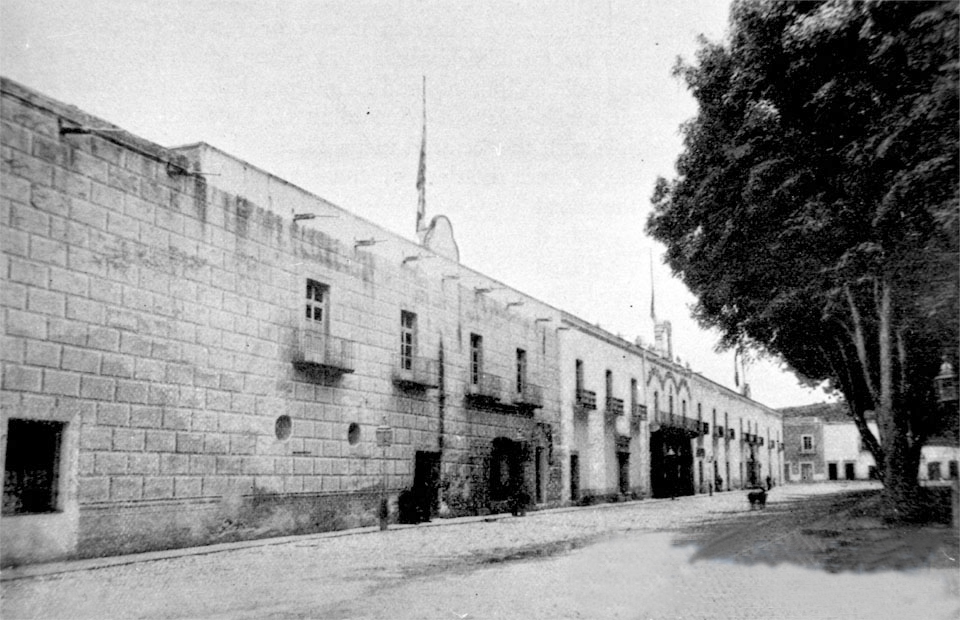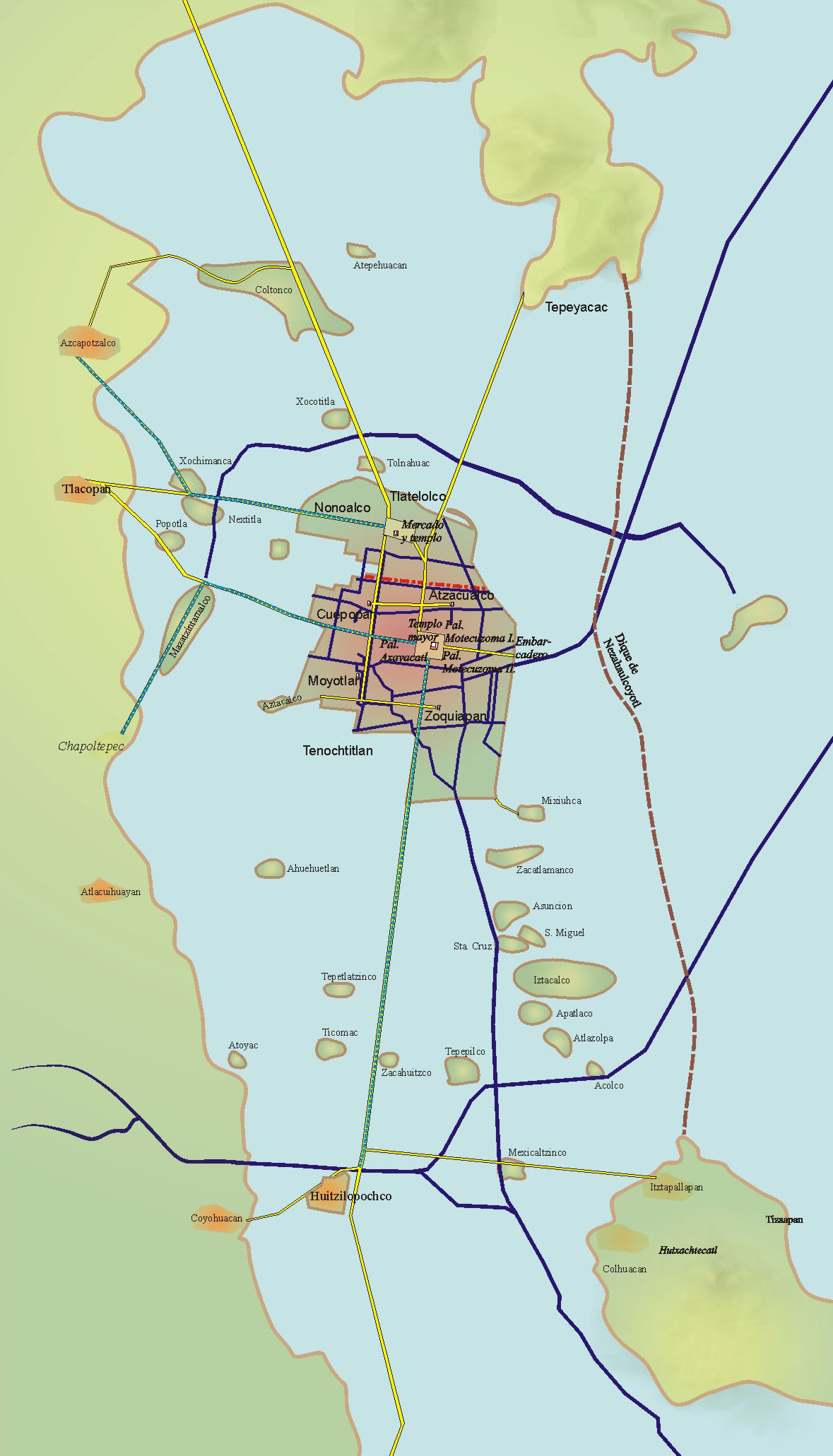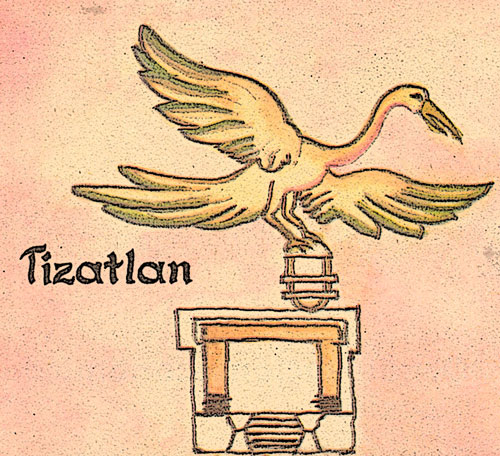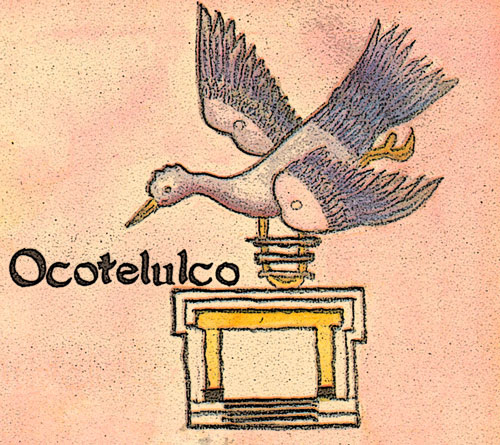|
Tlaxcala (city)
Tlaxcala ( , , ), officially Tlaxcala de Xicohténcatl, is the capital city of the Mexico, Mexican List of states of Mexico, state of Tlaxcala and seat of the Municipalities of Tlaxcala, municipality of the same name. The city did not exist during the pre-Hispanic period but was laid out by the Spanish Empire, Spanish as a center of evangelization and governance after the Spanish conquest of the Aztec Empire. The city was designated as a diocese but eventually lost that status to Puebla, Puebla, Puebla as its population declined. The city still has many of its old colonial structures, including the former Franciscan monastery, and newer civic structures like the Xicohtencatl Theatre. History The name Tlaxcala most likely comes from a Nahuatl phrase which means “place of corn bread.” The Aztec glyph for the Mesoamerican dominion is two hills from which emerge a pair of hands making a tortilla. The site of the modern city did not have a settlement for most of the pre Hispanic ... [...More Info...] [...Related Items...] OR: [Wikipedia] [Google] [Baidu] |
City
A city is a human settlement of a substantial size. The term "city" has different meanings around the world and in some places the settlement can be very small. Even where the term is limited to larger settlements, there is no universally agreed definition of the lower boundary for their size. In a narrower sense, a city can be defined as a permanent and Urban density, densely populated place with administratively defined boundaries whose members work primarily on non-agricultural tasks. Cities generally have extensive systems for housing, transportation, sanitation, Public utilities, utilities, land use, Manufacturing, production of goods, and communication. Their density facilitates interaction between people, government organisations, government organizations, and businesses, sometimes benefiting different parties in the process, such as improving the efficiency of goods and service distribution. Historically, city dwellers have been a small proportion of humanity overall, bu ... [...More Info...] [...Related Items...] OR: [Wikipedia] [Google] [Baidu] |
Puebla
Puebla, officially the Free and Sovereign State of Puebla, is one of the 31 states that, along with Mexico City, comprise the Federal Entities of Mexico. It is divided into 217 municipalities and its capital is Puebla City. Part of east-central Mexico, it is bordered by the states of Veracruz to the north and east, Hidalgo, México, Tlaxcala and Morelos to the west, and Guerrero and Oaxaca to the south. The origins of the state lie in the city of Puebla, which was founded by the Spanish in this valley in 1531 to secure the trade route between Mexico City and the port of Veracruz. By the end of the 18th century, the area had become a colonial province with its own governor, which would become the State of Puebla, after the Mexican War of Independence in the early 19th century. Since that time the area, especially around the capital city, has continued to grow economically, mostly through industry, despite being the scene of a number of battles, the most notable of which bei ... [...More Info...] [...Related Items...] OR: [Wikipedia] [Google] [Baidu] |
La Noche Triste
La Noche Triste ("The Night of Sorrows", literally "The Sad Night"), was an important event during the Spanish conquest of the Aztec Empire, wherein Hernán Cortés, his army of Spanish conquistadors, and their native allies were driven out of the Aztec capital, Tenochtitlan. Prologue Cortés' expedition arrived at Tenochtitlan on November 8, 1519, taking up residence in a specially designated compound in the city. Soon thereafter, suspecting treachery on the part of their hosts, the Spaniards took Moctezuma II, the Aztec king or ''Tlatoani'', hostage. Though Moctezuma followed Cortés' instructions in continually assuring his subjects that he had been ordered by the gods to move in with the Spaniards and that he had done so willingly, the Aztecs suspected otherwise. During the following 98 days, Cortés and his native allies, the Tlaxcaltecs, were increasingly unwelcome guests in the capital. Cortés heads off Spanish punitive expedition In May 1520, news from the Gulf coast r ... [...More Info...] [...Related Items...] OR: [Wikipedia] [Google] [Baidu] |
Hernán Cortés
Hernán Cortés de Monroy y Pizarro Altamirano, 1st Marquis of the Valley of Oaxaca (December 1485 – December 2, 1547) was a Spanish ''conquistador'' who led an expedition that caused the fall of the Aztec Empire and brought large portions of what is now mainland Mexico under the rule of the King of Castile in the early 16th century. Cortés was part of the generation of Spanish explorers and conquistadors who began the first phase of the Spanish colonization of the Americas. Born in Medellín, Spain, to a family of lesser nobility, Cortés chose to pursue adventure and riches in the New World. He went to Hispaniola and later to Cuba, where he received an ''encomienda'' (the right to the labor of certain subjects). For a short time, he served as ''alcalde'' (magistrate) of the second Spanish town founded on the island. In 1519, he was elected captain of the third expedition to the mainland, which he partly funded. His enmity with the governor of Cuba, Diego Velázquez de Cué ... [...More Info...] [...Related Items...] OR: [Wikipedia] [Google] [Baidu] |
Flower Wars
A flower war or flowery war (, ) was a ritual war fought intermittently between the Aztec Triple Alliance and its enemies on and off for many years in the vicinity and the regions around the ancient and vital city of Tenochtitlan, probably ending with the arrival of the Spaniards in 1519. Enemies included the city-states of Tlaxcala, Huejotzingo, and Cholula in the Tlaxcala-Pueblan Valley in central Mexico. In these wars, participants would fight according to a set of conventions. During the Spanish conquest of the Aztec Empire, Tlaxcala allied with the Spaniards against the Aztecs, being eager to see their longtime flower war enemies overthrown. Origins Texcocan nobleman Ixtlilxochitl gives the "fullest early statement concerning the origin as well as the initial rationale" of the flower war. From 1450 to 1454, the Aztecs had suffered from crop failure and severe drought; this led to famine and many deaths in the central Mexican highlands. Ixtlilxochitl reports that the fl ... [...More Info...] [...Related Items...] OR: [Wikipedia] [Google] [Baidu] |
Aztec Empire
The Aztec Empire, also known as the Triple Alliance (, Help:IPA/Nahuatl, [ˈjéːʃkaːn̥ t͡ɬaʔtoːˈlóːjaːn̥]) or the Tenochca Empire, was an alliance of three Nahuas, Nahua altepetl, city-states: , , and . These three city-states ruled that area in and around the Valley of Mexico from 1428 until the combined forces of the Spanish and their native allies who ruled under Spanish conquest of the Aztec Empire, defeated them in 1521. Its people and civil society are historiographically referred to as the ''Aztecs'' or the ''Culhua-Mexica''. The alliance was formed from the victorious factions of a civil war fought between the city of and its former tributary provinces. Despite the initial conception of the empire as an alliance of three self-governed city-states, the capital became dominant militarily. By the time the Spanish arrived in 1519, the lands of the alliance were effectively ruled from , while other partners of the alliance had taken subsidiary roles. The al ... [...More Info...] [...Related Items...] OR: [Wikipedia] [Google] [Baidu] |
Aztec
The Aztecs ( ) were a Mesoamerican civilization that flourished in central Mexico in the Post-Classic stage, post-classic period from 1300 to 1521. The Aztec people included different Indigenous peoples of Mexico, ethnic groups of central Mexico, particularly those groups who spoke the Nahuatl, Nahuatl language and who dominated large parts of Mesoamerica from the 14th to the 16th centuries. Aztec culture was organized into city-states (''altepetl''), some of which joined to form alliances, political confederations, or empires. The Aztec Empire was a confederation of three city-states established in 1427: Tenochtitlan, the capital city of the Mexica or Tenochca, Tetzcoco (altepetl), Tetzcoco, and Tlacopan, previously part of the Tepanec empire, whose dominant power was Azcapotzalco (altepetl), Azcapotzalco. Although the term Aztecs is often narrowly restricted to the Mexica of Tenochtitlan, it is also broadly used to refer to Nahuas, Nahua polities or peoples of central Pre ... [...More Info...] [...Related Items...] OR: [Wikipedia] [Google] [Baidu] |
Quiahuiztlan
Quiahuiztlan was one of the four ''altepetl'' (polities) that made up the confederation of Tlaxcala (Nahua state), Tlaxcala. It is located in the modern city of Tlaxcala, Tlaxcala, Tlaxcala, Tlaxcala, Tlaxcala State, Mexico. History Quiahuiztlan in Tlaxcala State shares the same name as a settlement in modern Veracruz State that was occupied in the 16th century CE as part of the Totonac culture. The two places are unrelated. The Quiahuztlan in modern Veracruz State has temples, ballcourt, plazas and residences, which are built on artificial and natural terraces on the fairly high relief flanks of the mountain. The site is most-likely famous for its association with the Spanish conquistador Hernán Cortés.Diaz, B., 1963, The Conquest of New Spain, London: Penguin Books, Excavations conducted at Quiahuiztlan were conducted by Alfonso Medellín Zenil and Ramón Arellanos Melgarejo, from the Instituto Nacional de Antropología e Historia. In the early 16th century, Quiahuiztlan ... [...More Info...] [...Related Items...] OR: [Wikipedia] [Google] [Baidu] |
Tizatlan
Tizatlan, in pre-Columbian Mexico, was one of the four independent altepemeh (polities, sing. altepetl) that constituted the confederation of Tlaxcallan. Today Tizatlan is a part of the modern city of Tlaxcala, and the Pre-Columbian city is visible as a small archaeological site in the San Esteban Tizatlán district of the city. The site is in the state of Tlaxcala in central Mexico. The name is Nahuatl and contains the elements ''tizatl'' (chalk) and ''tlan'' (place). History Tizatlan was the third of the four altepemeh to be founded, but at the time of the Spanish conquest of Mexico it was, along with Ocotelolco, the most powerful of the four allied communities. Where Ocotelolco held the economical power, having the main market in the region, Tizatlan had the military power and commanded the Tlaxcallan armies. When the Spanish arrived in Mexico Tizatlan was ruled by the aging Xicotencatl I "the Elder" aided by his son the military leader Xicotencatl II "the Younger". ... [...More Info...] [...Related Items...] OR: [Wikipedia] [Google] [Baidu] |
Ocotelolco
Ocotelolco (sometimes spelled Ocotelulco), in pre-Columbian Mexico, was one of the four independent altepetl (polities) that constituted the confederation of Tlaxcallan. The site is in the present day state of Tlaxcala in central Mexico. History Ocotelolco was the second of the four altepetl to be founded. At the time of the Spanish conquest of Mexico it was, along with Tizatlan, the most powerful of the four allied communities. Where Ocotelolco held the economical power, having the main market in the region, Tizatlan had the military power and commanded the Tlaxcallan armies. When the Spanish arrived in Mexico Ocotelolco was ruled by Maxixcatzin MaxixcatlThe Nahuatl name is often used in the honorific form as Maxixcatzin. was the tlatoani (ruler) of the Nahua altepetl (city-state) of Ocotelolco, one of the four towns that formed the state of Tlaxcallan. He was one of the main signers .... Through a series of political events Ocotelolco finally achieved dominance over Tiz ... [...More Info...] [...Related Items...] OR: [Wikipedia] [Google] [Baidu] |
Tepeticpac
Tepeticpac was one of the four ''altepetl'' (polities) that made up the confederation of Tlaxcala in pre-Columbian Mexico. It was the northwest-most altepetl, located west of the Atzompa river and north of Quiahuiztlan, and the first of the four major Tlaxcalan cities to be founded. The site is in the present day state of Tlaxcala in central Mexico. The ruins of Tepeticpac are located on a hill overlooking the city of Tlaxcala Tlaxcala, officially the Free and Sovereign State of Tlaxcala, is one of the 32 federal entities that comprise the Political divisions of Mexico, Federal Entities of Mexico. It is divided into Municipalities of Tlaxcala, 60 municipalities and t ... at an elevation of and is reachable only by foot path. References *Muñoz Camargo, Diego (1892 (1585)Historia de Tlaxcala published and annotated by Alfredo Chavero, Mexico. External links Altepetl Archaeological sites in Tlaxcala Mesoamerican sites {{mesoamerica-stub ... [...More Info...] [...Related Items...] OR: [Wikipedia] [Google] [Baidu] |








